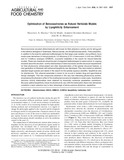| dc.rights.license | http://creativecommons.org/licenses/by-nc-sa/3.0/ve/ | |
| dc.contributor.author | Macías, Francisco A. | es_VE |
| dc.contributor.author | Marín, David | es_VE |
| dc.contributor.author | Oliveros Bastidas, Alberto | es_VE |
| dc.contributor.author | Molinillo G., José | es_VE |
| dc.date | 2007-04-09 | es_VE |
| dc.date.accessioned | 2007-04-09T09:00:00Z | |
| dc.date.available | 2007-04-09T09:00:00Z | |
| dc.date.created | 2006-01-01 | es_VE |
| dc.date.issued | 2007-04-09T09:00:00Z | es_VE |
| dc.identifier.other | T016300003777/0 | es_VE |
| dc.identifier.uri | http://www.saber.ula.ve/handle/123456789/16807 | |
| dc.description.abstract | Optimization of Benzoxazinones as natural herbicide models by Lipophilicity Enhancement.
(Macías, Francisco A.; Marín, David; Oliveros Bastidas, Alberto y Molinillo G., José
Abstract
Benzoxazinones are plant allelochemicals well-known for their phytotoxic activity and for taking part in the defense
strategies of Gramineae, Ranunculaceae, and Scrophulariceae plants. These properties, in addition to the recently optimized
methodologies for their large-scale isolation and synthesis, have made some derivatives of natural products,
2,4-dihydroxy-(2H)-1,4-benzoxazin-3-(4H)-one (DIBOA) and its 7-methoxy analogue (DIMBOA), successful templates in the search for natural herbicide models. These new chemicals should be part of integrated methodologies for weed control. In ongoing research about the structure-activity relationships of benzoxazinones and the structural requirements for their phytotoxicity enhancement and after characterization of the optimal structural features, a new generation of chemicals with enhanced lipophilicity was developed. They were tested on selected standard target species and weeds in the search for the optimal aqueous solubility-lipophilicity rate for phytotoxicity. This physical parameter is known to be crucial in modern drug and agrochemical design strategies. The new compounds obtained in this way had interesting phytotoxicity profiles, empowering the phytotoxic effect of the starting benzoxazinone template in some cases. Quantitative structure-activity relationships were obtained by bioactivity-molecular parameters correlations.
Because optimal lipophilicity values for phytotoxicity vary with the tested plant, these new derivatives constitute a more selective way to take advantage of benzoxazinone phytotoxic capabilities. | es_VE |
| dc.format.extent | 491194 | es_VE |
| dc.language.iso | es | es_VE |
| dc.publisher | SABER ULA | es_VE |
| dc.rights | info:eu-repo/semantics/openAccess | |
| dc.subject | Grupo de Química Ecológica | es_VE |
| dc.title | Optimization of Benzoxazinones as natural herbicide models by Lipophilicity enhancement. | es_VE |
| dc.type | info:eu-repo/semantics/article | |
| dc.description.email | famacias@uca.es | es_VE |
| dc.description.email | aloliver@ula.ve | es_VE |
| dc.description.tiponivel | Nivel monográfico | es_VE |
| dc.subject.departamento | Departamento de Química | es_VE |
| dc.subject.escuela | Escuela de Ciencias. | es_VE |
| dc.subject.facultad | Facultad de Ciencias. | es_VE |
| dc.subject.keywords | Allelochemicals | es_VE |
| dc.subject.keywords | DIBOA | es_VE |
| dc.subject.keywords | DIMBOA | es_VE |
| dc.subject.keywords | D-DIBOA | es_VE |
| dc.subject.keywords | Lipophilicity | es_VE |
| dc.subject.keywords | Herbicides | es_VE |
| dc.subject.keywords | Structure Activity Relationships (SAR) | es_VE |
| dc.subject.tipo | Artículos | es_VE |


